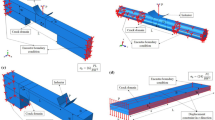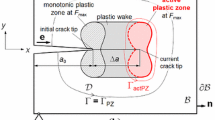Abstract
The paper considers the near-tip J-integral \(\text {J}_{\mathrm{tip}}\), the far-field J-integral \(\text {J}_{\mathrm{far}} \), and the experimental J-integral \(\text {J}^{\mathrm{exp}}\) in a material with sinusoidal variation of the Young’s modulus \(E\). The evaluations of \(\text {J}_{\mathrm{tip}} \) and \(\text {J}_{\mathrm{far}} \) are based on the concept of configurational forces; \(\text {J}^{\mathrm{exp}}\) is evaluated from the area below the load point displacement curve, as prescribed by the standard testing procedures. Analytic expressions and/or approximation formulae are derived, how \(\text {J}_{\mathrm{tip}} ,\,\text {J}_{\mathrm{far}} \) and \(\text {J}^{\mathrm{exp}}\) depend on the system parameters of the material, i.e. wavelength and amplitude of the \(E\)-variation and its phase shift with respect to the crack tip position, and the global specimen dimensions. The analyses show that \(\text {J}_{\mathrm{tip}} \) and \(\text {J}_{\mathrm{far}} \) exhibit a strong dependency on the phase shift, but not the experimental J-integral \(\text {J}^{\mathrm{exp}}\). This is the reason why the current procedures for fracture mechanics testing are not suitable to determine the true values of the fracture initiation toughness \(\text {J}_\mathrm{i} \) or the crack growth resistance \(R\) of a material, if the material properties exhibit a spatial variation in the direction of crack propagation. Relations are given to estimate the possible errors.







Similar content being viewed by others
References
Abeyaratne R, Knowles JK (2006) Evolution of phase transitions—a continuum theory. Cambridge University Press, Cambridge, UK
ASTM E1820–05 (2005) Standard test method for measurement of fracture toughness. In: Annual book of ASTM standards, vol 03.01. ASTM International, West Conshohocken, PA, USA
Carpinteri A (1994) Scaling laws and renormalization groups for strength and toughness of disordered materials. Int J Solids Struct 31:291–302
Carpinteri A, Paggi M (2005) On the asymptotic stress field in angularly nonhomogeneous materials. Int J Fract 135:267–283
Carpinteri A, Pugno N (2005) Are scaling laws on strength of solids related to mechanics or to geometry? Nat Mater 4:421–423
Chen CR, Pascual J, Fischer FD, Kolednik O, Danzer R (2007) Prediction of the fracture toughness of a ceramic multilayer composite—modeling and experiments. Acta Mater 55:409–421
Cravero S, Ruggieri C (2007) Estimation procedure of\(J\)-resistance curves for SE(T) fracture specimens using unloading compliance. Eng Fract Mech 74:2735–2757
Delale F, Erdogan F (1983) The crack problem for a nonhomogeneous plane. ASME J Appl Mech 50:609–614
Eischen F (1995) Fracture of nonhomogeneous materials. J Fract 34:3–22
Erdogan F, Kaya AC, Joseph PF (1991) The crack problem in bonded nonhomogeneous materials. ASME J Appl Mech 58:410–418
Eshelby JD (1956) The continuum theory of lattice defects. In: Seitz F, Turnbull D (eds) Solid state physics. Advances and applications. Academic Press, New York, pp 79–144
ESIS P2–92 (1992) ESIS Procedure for Determining the Fracture Behaviour of Materials. European Structural Integrity Society, Delft, The Netherlands
Fischer FD, Predan J, Kolednik O, Simha NK (2007) Application of material forces to fracture of inhomogeneous materials: illustrative examples. Arch Appl Mech 77:95–112
Fischer FD, Predan J, Fratzl P, Kolednik O (2012a) Semi-analytical approaches to assess the crack driving force in periodically heterogeneous elastic materials. Int J Fract 173:57–70
Fischer FD, Simha NK, Predan J, Schöngrundner R, Kolednik O (2012b) On configurational forces at boundaries in fracture mechanics. Int J Fract 174:61–74
Fratzl P, Gupta HS, Fischer FD, Kolednik O (2007) Hindered crack propagation in materials with periodically varying Young’s modulus—lessons from biological materials. Adv Mater 19:2657–2661
Gao H (1991) Fracture analysis of nonhomogenous materials via a moduli perturbation approach. Int J Solids Struct 27:1663–1682
Gross D, Seelig T (2001) Bruchmechanik, 3rd edn. Springer, Berlin
Gurtin ME (2000) Configurational forces as basic concepts of continuum physics. Springer, Berlin
Kienzler R, Herrmann G (2000) Mechanics in material space. Springer, Berlin
Kolednik O (2000) The yield-stress gradient effect in inhomogeneous materials. Int J Solids Struct 37:781–808
Kolednik O, Predan J, Shan GX, Simha NK, Fischer FD (2005) On the fracture behavior of inhomogeneous materials—a case study for elastically inhomogeneous bimaterials. Int J Solids Struct 42:605–620
Kolednik O, Predan J, Fischer FD (2010) Reprint of “Cracks in inhomogeneous materials: comprehensive assessment using the configurational forces concept”. Eng Fract Mech 77:3611–3624
Kolednik O, Predan J, Fischer FD, Fratzl P (2011) Bioinspired design criteria for damage-resistant materials with periodically varying microstructure. Adv Funct Mater 21:3634–3641
Kolednik O, Schöngrundner R, Fischer FD (2014a) A new view on \(J\)-integrals in elastic-plastic materials. Int J Fract 187:77–107
Kolednik O, Predan J, Fischer FD, Fratzl P (2014b) Improvements of strength and fracture resistance by spatial material property variations. Acta mater 68:279–294
Maugin GA (1993) Material inhomogeneities in elasticity. Chapman & Hall, London, UK
Maugin GA (1995) Material forces: concepts and applications. ASME Appl Mech Rev 48:213–245
Maugin GA (2010) Configurational forces: thermomechanics, physics, mathematics, and numeric. CRC Press, Boca Raton, USA
Muju S (2000) Crack propagation in immaterial multilayered periodically microcracking composite media. Compos Sci Technol 60:2213–2221
Müller R (2005) Configurational forces in defect mechanics and in computational methods. Forschungsbericht Band 13, TU Darmstadt, Germany
Ostoja-Starzewski M (1998) Random field models of heterogeneous materials. Int J Solids Struct 35:2429–2455
Ostoja-Starzewski M (2014) From fractal media to continuum mechanics. ZAMM J Appl Math Mech 94:373–401
Rakin M, Kolednik O, Medjo B, Simha NK, Fischer FD (2009) A case study on the effect of thermal residual stresses on the crack-driving force in linear-elastic bimaterials. Int J Mech Sci 51:531–540
Rice JR (1968a) A path independent integral and the approximate analysis of strain concentration by notches and cracks. ASME J Appl Mech 35:379–386
Rice JR (1968b) Mathematical analysis in the mechanics of fracture. In: Liebowitz H (ed) Fracture—an advanced treatise, vol 2. Academic Press, New York, pp 191–311
Rice JR, Paris PC, Merkle JG (1973) Some further results of\(J\)-integral analysis and estimates. ASTM STP 536:231–245
Simha NK, Fischer FD, Kolednik O, Chen CR (2003) Inhomogeneity effects on the crack driving force in elastic and elastic-plastic materials. J Mech Phys Solids 51:209–240
Simha NK, Fischer FD, Shan GX, Chen CR, Kolednik O (2008) \(J\)-Integral and crack driving force in elastic-plastic materials. J Mech Phys Solids 56:2876–2895
Steinmann P (2000) Application of material forces to hyperelastostatic fracture mechanics: I. Continuum mechanical setting. Int J Solids Struct 37:7371–7391
Tomar V, Zhou M (2005) Deterministic and stochastic analyses of fracture processes in a brittle microstructure system. Eng Fract Mech 72:1920–1941
Acknowledgments
Financial support by the Austrian Federal Government and the Styrian Provincial Government within the research activities of the K2 Competence Center on “Integrated Research in Materials, Processing and Product Engineering”, under the frame of the Austrian COMET Competence Center Programme, is gratefully acknowledged (Strategic project A4.20-WP1).
Author information
Authors and Affiliations
Corresponding author
Appendix: Integrals
Appendix: Integrals
1.1 Integral \(I_\mathrm{u} \)
The integral \(I_\mathrm{u} \left( {{E_\mathrm{A} }/{E_0 }, {X_0 }/\lambda , R/\lambda } \right) \), Eq. (14b), is re-formulated with \(E\left( x \right) \) from Eq. (3) in the form
This integral can be solved both numerically and analytically, see e.g. http://www.wolfram.com/mathematica. Analytical solutions are given for \(R/{\lambda =1}\) and two different values for the relative phase shift, \({X_0 }/\lambda =1/2\) (corresponding to the location of the maxima in \(\text {J}_{\mathrm{tip}})\) and \({X_0 }/\lambda =0\) or 1 (corresponding to the location of the minima in \(\text {J}_{\mathrm{tip}})\) as
The quantity \(\hbox {J}_1 \) symbolizes the Bessel function of first kind of order 1.
1.2 Integral \(I_\mathrm{t} \)
The integral \(I_\mathrm{t} \left( {{E_\mathrm{A} }/{E_0 }, {X_0 }/\lambda , R/\lambda } \right) \), Eq. (14c), follows with Eq. (12b) as
This integral must be solved numerically. Note that the integrand becomes an indefinite form \(0/0\) for \({\theta =\pi }/2\), identified as \(\left( {3-\nu } \right) /4\cdot 2\pi R/\lambda \times E_\mathrm{A} \cos \left( {2\pi {X_0 }/\lambda } \right) /E\left( {x=0} \right) \).
To avoid numerical problems \({E_\mathrm{A} }/{E_0 }\) should be kept smaller than 0.999.
Rights and permissions
About this article
Cite this article
Fischer, F.D., Predan, J., Müller, R. et al. On problems with the determination of the fracture resistance for materials with spatial variations of the Young’s modulus. Int J Fract 190, 23–38 (2014). https://doi.org/10.1007/s10704-014-9972-2
Received:
Accepted:
Published:
Issue Date:
DOI: https://doi.org/10.1007/s10704-014-9972-2




